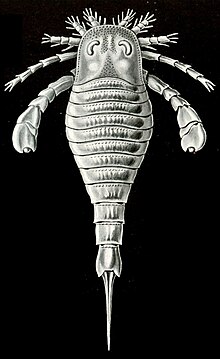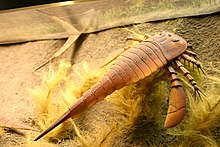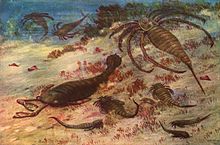Eurypterid
| Eurypterida Temporal range:
| |
|---|---|

| |
| Eurypterid from Ernst Haeckel's Kunstformen der Natur (1904) | |
| Scientific classification | |
| Kingdom: | |
| Phylum: | |
| Subphylum: | |
| Class: | |
| Order: | †Eurypterida Burmeister, 1843
|
| Suborders | |
|
†Stylonurina Diener, 1924 | |
Eurypterids (sea scorpions) are an extinct group of arthropods related to arachnids which include the largest known arthropods that ever lived. They are members of the extinct order Eurypterida (Chelicerata); which is the most diverse Paleozoic chelicerate order in terms of species.[1] The name Eurypterida comes from the Greek word eury- meaning "broad" or "wide" and the Greek word pteron meaning "wing",[2] for the pair of wide swimming appendages on the first fossil eurypterids discovered. Eurypterids predate the earliest fishes. The largest, such as Jaekelopterus, reached 2.5 metres (8 ft 2 in) or more in length, but most species were less than 20 centimetres (8 in). They were formidable predators that thrived in warm shallow water, in both seas and lakes,[3] in the Ordovician to Permian from 460 to 248 million years ago. Although informally called 'sea scorpions', only the earliest ones were marine (later ones lived in brackish or freshwater), and they were not true scorpions. According to theory, the move from the sea to fresh water probably occurred by the Pennsylvanian subperiod. Eurypterids are believed to have undergone ecdysis, making their significance in ecosystems difficult to assess, because it can be difficult to tell a fossil moult from a true fossil carcass.[4] They went extinct during the Permian–Triassic extinction event 251.902 million years ago, and their fossils have a near global distribution.
About two dozen families of eurypterids are known. Perhaps the best-known genus of eurypterid is Eurypterus, of which around 16 fossil species are known. The genus Eurypterus was created in 1825 by James Ellsworth De Kay, a zoologist. He recognized the arthropod nature of the first ever described eurypterid specimen, found by Dr. S. L. Mitchill. In 1984, that species, Eurypterus remipes was named the state fossil of New York.
Body structure

Eurypterids have been formally described as follows:[5]
"Small to very large merostomes with elongate lanceolate, rarely trilobed body; prosoma [head] of moderate size; opisthosoma [body] with 12 moveable segments and styliform to spatulate telson [tail], with division commonly into 7-segmented preabdomen and 5-segmented postabdomen; prosomal [head] appendages 6, comprising 3-jointed chelicerae, walking legs, the last pair commonly transformed into swimming legs. Mouth central, bordered posteriorly by endostoma and metastoma. Operculum with median genital appendage, abdominal appendages plate-shaped with nonlaminate gills. Ordovician-Permian."
The typical eurypterid had a large, flat, semicircular carapace, followed by a jointed section, and finally a tapering, flexible tail, most ending with a long spine at the end (Pterygotus, though, had a large flat tail, possibly with a smaller spine). Behind the head of the eurypterids were twelve body segments. These segments are formed by a dorsal plate called tergite, and a ventral plate called sternite. The tail, known as the telson, is spiked in most eurypterids like in modern scorpions and in some species it may have been used to inject venom, but so far there is no certain evidence any eurypterids were venomous. Most eurypterids have paddles toward the end of the carapace and beyond, which were used to propel themselves through water. The suborder Stylonurina have walking legs instead of paddles. Some argue that the paddles were also used for digging. It is possible that it was used for both. Underneath, in addition to the pair of swimming appendages the creature had 4 pairs of jointed legs for walking, and two claws at the front, chelicerae, which were enlarged in pterygotids. The walking legs had odd hairs, similar to modern day crabs. Other features, common to ancient and modern arthropods of this type, include one pair of compound eyes and a pair of smaller eyes called ocelli, between the other larger pair of eyes.

Many eurypterids had legs large and long enough to do more than allow them to crawl over the sea bottom; a number of species (particularly hibbertopterids) had large stout legs, and were probably capable of terrestrial locomotion (like land crabs today). Studies of what are believed to be their trackways indicate that eurypterids used in-phase, hexapodous (six-legged) and octopodous (eight-legged) gaits. Some species may have been amphibious, emerging onto land for at least part of their life cycle; they may have been capable of breathing both in water and in air.[6] A predatory arthropod whose traces are known as Protichnites,[7] found in Cambrian strata dating from 510 million years ago, is a possible stem group eurypterid, and is among the first evidence of animals on land.[8]
Among the largest eurypterids are the hibbertopteroids, named after the British palaeontologist Dr. Samuel Hibbert, who described Hibbertopterus scouleri at the East Kirkton limestone quarry in Scotland in 1836. Fossil tracks (a form of trace fossil) were identified recently in East Lothian, Scotland, as made by a 1.6 metre long Hibbertopterus.[9] The largest well-described genus of sea-scorpion was Pterygotus, an arthropod the size of a crocodile. Fossils of Pterygotus are relatively common although complete fossils are rare. At 2.1 metres (6 ft 11 in) long, they were until recently the largest known arthropod ever to have lived. Their fossils have been found worldwide, except in Antarctica. In 2007, a 46 cm (18 in) claw belonging to Jaekelopterus rhenaniae (a species originally described in 1914) was discovered by a group of paleontologists led by Simon Braddy at the University of Bristol, indicating that J. rhenaniae was 2.5 m (8 ft 2 in) in length, making it the largest arthropod ever found.[10][11]
Relationships with other groups

Eurypterids have traditionally been regarded as close relatives of horseshoe crabs, together forming a group called Merostomata. Subsequent studies placed eurypterids closer to the arachnids in a group called Metastomata.[12] There has also been a =1920 |title=Die Ve rwandtschaft der Merostomata mit den journal |author chasmataspid, Loganamaraspis dunlopi gen. et sp. nov. (Chelicerata: Chasmataspidida) from Lesmahagow, Scotland, and its implications for eurypterid phylogeny |journal=Transactions of the Royal Society of Edinburgh: Earth Sciences |volume=94 |issue=3 |pages=227–234 |doi=10.1017/S0263593300000638}}</ref> and the two groups were sometimes confused with one another. The most recent summary of relationships between arachnids and their relatives recognised Eurypterida, Xiphosura and Arachnida as three major groups, but was not able to resolve any shared details among them.[13]
List of families and genera




There are 246 valid species of eurypterids as of 2011. All of them are extinct. They are grouped into the following:[14]
- Suborder Stylonurina Diener, 1924
-
- Superfamily Rhenopteroidea Størmer, 1951
- Rhenopteridae Størmer, 1951
- Alkenopterus Størmer, 1974
- Brachyopterella Kjellesvig-Waering, 1966
- Brachyopterus Størmer, 1951
- Kiaeropterus Waterston, 1979
- Leiopterella Lamsdell, Braddy, Loeffler, & Dineley, 2010
- Rhenopterus Størmer, 1936
- Superfamily Stylonuroidea Kjellesvig-Waering, 1959
- Parastylonuridae Waterston, 1979
- Parastylonurus Kjellesvig-Waering, 1966
- Stylonurella Kjellesvig-Waering, 1966
- Stylonuridae Diener, 1924
- Ctenopterus Clarke & Ruedemann, 1912
- Laurieipterus Kjellesvig-Waering, 1966
- Pagea Waterston, 1962
- Stylonurus Page, 1856
- Superfamily Kokomopteroidea Kjellesvig-Waering, 1966
- Kokomopteridae Kjellesvig-Waering, 1966
- Kokomopterus Kjellesvig-Waering, 1966
- Lamontopterus Waterston, 1979
- Hardieopteridae Tollerton, 1989
- Hallipterus Kjellesvig-Waering, 1963
- Tarsopterella Størmer, 1951
- Superfamily Hibbertopteroidea Kjellesvig-Waering, 1959
- Drepanopteridae Kjellesvig-Waering, 1966
- Drepanopterus Laurie, 1892
- Hibbertopteridae Kjellesvig-Waering, 1959
- Campylocephalus Eichwald, 1860
- Cyrtoctenus Størmer & Waterston, 1968
- Dunsopterus Waterston, 1968
- Hastimima White, 1908
- Hibbertopterus Kjellesvig-Waering, 1959
- Vernonopterus Waterston, 1957
- Mycteroptidae Cope, 1886
- Megarachne Hünicken, 1980
- Mycterops Cope, 1886
- Woodwardopterus Kjellesvig-Waering, 1959
- Stylonuroides Kjellesvig-Waering, 1966
- Suborder Eurypterina Burmeister, 1843
-
- Plesion taxa
- Onychopterella Størmer, 1951
- Superfamily Moselopteroidea Lamsdell, Braddy, & Tetlie, 2010
- Moselopteridae Lamsdell, Braddy, & Tetlie, 2010
- Moselopterus Størmer, 1974
- Vinetopterus Poschmann & Tetlie, 2004
- Superfamily Megalograptoidea Caster & Kjellesvig-Waering, 1955
- Megalograptidae Caster & Kjellesvig-Waering, 1955
- Echinognathus Walcott, 1882
- Megalograptus Miller, 1874
- Superfamily Eurypteroidea Burmeister, 1843
- Dolichopteridae Kjellesvig-Waering & Størmer, 1952
- Dolichopterus Hall, 1859
- Ruedemannipterus Kjellesvig-Waering, 1966
- Buffalopterus Kjellesvig-Waering & Heubusch, 1962
- Strobilopterus Ruedemann, 1935
- Syntomopterus Kjellesvig-Waering, 1961
- Eurypteridae Burmeister, 1843
- Eurypterus De Kay, 1825
- Erieopteridae Tollerton, 1989
- Erieopterus Kjellesvig-Waering, 1958
- Superfamily Mixopteroidea Caster & Kjellesvig-Waering, 1955
- Carcinosomatidae Størmer, 1934
- Carcinosoma Claypole, 1890
- Eocarcinosoma Caster & Kjellesvig-Waering, 1964
- Paracarcinosoma Caster & Kjellesvig-Waering, 1964
- Rhinocarcinosoma Novojilov, 1962
- Micopteridae Caster & Kjellesvig-Waering, 1955
- Lanarkopterus Ritchie, 1968
- Mixopterus Ruedemann, 1921
- Superfamily Waeringopteroidea
- Waeringopteridae (not formally published)
- Grossopterus Størmer, 1934
- Orcanopterus Stott, Tetlie, Braddy, Nowlan, Glasser, & Devereux, 2005
- Waeringopterus Leutze, 1961
- Superfamily Adelophthalmoidea Tollerton, 1989
- Adelophthalmidae Tollerton, 1989
- Adelophthalmus Jordan in Jordan & von Mayer, 1854
- Bassipterus Kjellesvig-Waering & Leutze, 1966
- Eysyslopterus Tetlie & Poschmann, 2008
- Nanahughmilleria Kjellesvig-Waering, 1961
- Parahughmilleria Kjellesvig-Waering, 1961
- Pittsfordipterus Kjellesvig-Waering & Leutze, 1966
- Superfamily Pterygotioidea Clarke & Ruedemann, 1912
- Hughmilleriidae Kjellesvig-Waering, 1951
- Herefordopterus Tetlie, 2006
- Hughmilleria Sarle, 1902
- Slimonidae Novojilov, 1968
- Slimonia Page, 1856
- Salteropterus Kjellesvig-Waering, 1951
- Pterygotidae Clarke & Ruedemann, 1912
- Pterygotus Agassiz, 1839
- Acutiramus Ruedemann, 1935
- Ciurcopterus Tetlie & Briggs, 2009
- Erettopterus Salter in Huxley & Salter, 1859
- Jaekelopterus Waterston, 1964
- Clarkiepterus Kjellesvig-Waering, 1966
- Dorfopterus Kjellesvig-Waering, 1955
- Holmipterus Kjellesvig-Waering, 1979
- Marsupipterus Caster & Kjellesvig-Waering, 1955
- Tylopterella Størmer, 1951
- Unionopterus Chernyshev, 1948
The trace fossil trackways produced by eurypterids are placed in the ichnogenus Palmichnium.[15]
Phylogeny

The cladogram presented here is simplified from a study by Tetlie.[16] The most important phylogenetic breakdown is based on the two major innovations that characterise the evolution of the eurypterids. The most important was the transformation of the posteriormost prosomal appendage into a swimming paddle (as found in the clade Eurypterina). The second innovation was the enlargement of the chelicerae, (as found in the family Pterygotidae), allowing these appendages to be used for active prey capture.
75% of eurypterid species are eurypterines; this represents 99% of specimens.[1] The superfamily Pterygotioidea is the most species-rich clade with 56 species, followed by the Adelophthalmoidea with 43 species; as sister taxa, they comprise the most derived eurypterids. Pterygotioidea includes the pterygotids, which are the only eurypterids to have a cosmopolitan distribution.[16] This clade is one of the best supported within the eurypterids.
It has been suggested that the development of dermal armour in certain groups of jawless vertebrates (such as the Heterostraci and the Osteostraci) is in response to predation pressure by increasingly sophisticated eurypterid predators[17] (specifically the pterygotids) although this has yet to be verified by detailed analysis.[18] An increase in fish diversity is tied to a decline in eurypterid diversity in the Lower Devonian,[19] although it is not thought that this represents competitive replacement; in fact, this is rare in the fossil record.[20]
| Eurypterida | |
See also
- List of eurypterids
- Nepidae – an unrelated insect, commonly known as a "water scorpion"
- Hibbertopterus
References
- ^ a b Dunlop, J. A. (2008). "How many species of fossil arachnids are there?". Journal of Arachnology. 36 (2): 267–272. doi:10.1636/CH07-89.1. ISSN 0161-8202.
{{cite journal}}: Unknown parameter|coauthors=ignored (|author=suggested) (help) - ^ Webster's New Universal Unabridged Dictionary. 2nd ed. 1979.
- ^ Joseph T. Hannibal, Spencer G. Lucas, Allan J. Lerner & Dan S. Chaney (2005). S. G. Lucas, K. E. Zeigler & J. A. Spielmann (ed.). "The Permian of Central New Mexico" (PDF). New Mexico Museum of Natural History and Science Bulletin. 31: 34–38.
{{cite journal}}:|chapter=ignored (help)CS1 maint: multiple names: authors list (link) - ^ Brandt, Danita (2009). "Scorpion taphonomy: criteria for distinguishing fossil scorpion molts and carcasses". Journal of Arachnology. 37.3: 312+.
{{cite journal}}:|access-date=requires|url=(help); Unknown parameter|coauthors=ignored (|author=suggested) (help) - ^ L. Størmer (1955). "Merostomata". Treatise on Invertebrate Paleontology, Part P Arthropoda 2, Chelicerata. p. 23.
- ^ "'Gigantic scorpion' fossil found in Fife". BBC News. April 24, 2010.
- ^ Richard Owen (1852). "Description of the impressions and footprints of the Protichnites from the Potsdam Sandstone of Canada". Quarterly Journal of the Geological Society of London. 8: 214–225. doi:10.1144/GSL.JGS.1852.008.01-02.26.
- ^ Lancaster D. Burling (1917). "Protichnites and Climactichnites. A critical study of some Cambrian trails". American Journal of Science. 44 (263): 387–398. doi:10.2475/ajs.s4-44.263.387.
- ^ Whyte, Martin A. (2005). "Palaeoecology: A gigantic fossil arthropod trackway". Nature. 438 (7068): 576–576. doi:10.1038/438576a. PMID 16319874.
- ^ Simon J. Braddy, Markus Poschmann & O. Erik Tetlie (2008). "Giant claw reveals the largest ever arthropod". Biology Letters. 4 (1): 106–109. doi:10.1098/rsbl.2007.0491. PMC 2412931. PMID 18029297.
- ^ "Giant claw points to monster sea scorpion". New Scientist. November 21, 2007.
- ^ P. Weygoldt & H. F. Paulus (1979). "Untersuchungen zur Morphologie, Taxonomie und Phylogenie der Chelicerata". Zeitschrift für zoologische Systematik und Evolutionsforschung. 17 (2): 85–116, 177–200. doi:10.1111/j.1439-0469.1979.tb00694.x.
- ^ Jeffrey W. Shultz (2007). "A phylogenetic analysis of the arachnid orders based on morphological characters" (PDF). Zoological Journal of the Linnean Society. 150 (2): 221–265. doi:10.1111/j.1096-3642.2007.00284.x.
- ^ Jason A. Dunlop, David Penney, & Denise Jekel; with additional contributions from Lyall I. Anderson, Simon J. Braddy, James C. Lamsdell, Paul A. Selden, & O. Erik Tetlie (2011). "A summary list of fossil spiders and their relatives". In Norman I. Platnick (ed.). [http://research.amnh.org/entomology/spiders/catalog/index.html The world spider catalog, version 11.5] (PDF). American Museum of Natural History. Retrieved May 21, 2011.
{{cite book}}: External link in|title= - ^ Adolf Seilacher (2007). "Arthropod trackways". Trace Fossil Analysis. Springer. pp. 18–31. ISBN 978-3-540-47225-4.
- ^ a b c O. Erik Tetlie (2007). "Distribution and dispersal history of Eurypterida (Chelicerata)" (PDF). Palaeogeography, Palaeoclimatology, Palaeoecology. 252 (3–4): 557–574. doi:10.1016/j.palaeo.2007.05.011.
- ^ Romer, A. S. (1933). "Eurypterid influence on vertebrate history". Science. 78 (2015): 114–117. doi:10.1126/science.78.2015.114. PMID 17749819.
- ^ a b O. Erik Tetlie & Derek E. G. Briggs (2009). "The origin of pterygotid eurypterids (Chelicerata: Eurypterida)". Palaeontology. 52 (5): 1141–1148. doi:10.1111/j.1475-4983.2009.00907.x.
- ^ D. E. G. Briggs (1988). "Extinction and the fossil record of arthropods". Clarendon press. In Extinction and survival in the fossil record (ed. G. P. Larwood): 171–209.
{{cite journal}}: Unknown parameter|coauthors=ignored (|author=suggested) (help) - ^ Ridley, Mark (2004). Evolution. Wiley-Blackwell. ISBN 978-1-4051-0345-9.
Further reading
- Braddy, Simon J. (2001). "Eurypterid Palaeoecology: palaeobiological, ichnological and comparative evidence for a 'mass-moult-mate' hypothesis". Palaeogeography, Palaeoclimatology, Palaeoecology. 172 (1–2): 115–132. doi:10.1016/S0031-0182(01)00274-7.
- Ciurca, Samuel J. (1998). "The Silurian Eurypterid Fauna". Retrieved July 25, 2004.
- Clarke, John M. & R. Rudolf (1912). The Eurypterida of New York. Albany, New York: New York State Education Department.
- Gupta, Neal S., O. Erik Tetlie, Derek E. G. Briggs & Richard D. Pancost (2007). "The fossilization of eurypterids: a result of molecular transformation" (PDF). Palaios. 22 (4): 439–447. doi:10.2110/palo.2006.p06-057r.
{{cite journal}}: CS1 maint: multiple names: authors list (link) - Manning, Phillip L. & Jason A. Dunlop (1995). "The respiratory organs of eurypterids" (PDF). Palaeontology. 38 (2): 287–297.
- Tetlie, O. Erik (2007). "Distribution and dispersal history of Eurypterida (Chelicerata)" (PDF). Palaeogeography, Palaeoclimatology, Palaeoecology. 252 (3–4): 557–574. doi:10.1016/j.palaeo.2007.05.011.
- Tetlie, O. Erik & Michael B. Cuggy (2007). "Phylogeny of the basal swimming eurypterids (Chelicerata; Eurypterida; Eurypterina)". Journal of Systematic Palaeontology. 5 (3): 345–356. doi:10.1017/S1477201907002131.
